Abigail Bicheno addresses some common gardening queries
Abigail is the Estate’s maintenance surveyor and is frequently asked about garden maintenance and common challenges. She offers some advice.

Abigail Bicheno
Now is the time to start planting next season's bulbs and making the most of the autumn fruits.
Winter 2020
There is still chance to get out and prepare your garden for spring
Possibly the last thing on your mind at this time of year is spending time gardening. However, if you pick a slot between showers, there is still plenty to do which will pay dividends come spring. November to March is the best time to prune most fruit trees and shrubs. Avoid the temptation to prune plums, stick to apples and pears. Some people find pruning bewildering, but if you follow a few rules this can be simplified.
For apple trees, first prune out any die back. This applies to all trees and shrubs, so cut back to green wood. Then thin out branches that cross over, they must not rub against one another as this can allow disease to enter under the damaged bark.
Then prune back hard to a main branch any small branches that shoot straight up to the sky. You are trying to achieve a low wide spread, with an open center. If you have a mature tree and there are lots of branches forming a thatch, thin them out - and don’t be shy here the tree won’t thank you for it. Prune all laterals above an outward facing bud.
Most flowing shrubs should be pruned straight after flowering, but if you missed this you can still do this now. Buddleias should be pruned hard in the spring just as the new shoots are showing, by contrast ceanothus need a light trim as they can keel over if you prune too hard.
Autumn 2020
Autumn ushers in bulb-planting season and drink-making opportunities
Nature is exhibiting a fabulous bounty of pears, apples and damsons which mass on cultivars and their wild cousins alike. I am spending time juicing apples and pears and turning them into cider. It is time consuming but simple, the fruit is crushed and pressed and the juice allowed to ferment until it clears, it can then be bottled with a pinch of sugar and stored ready for drinking after just a few months! For full instructions and other ideas go to bbcgoodfood.com/howto/guide/beginners-guide-fermented-foods.
At this time of year, all perennials that have finished flowering should be cut down to ground level and the prunings composted or mulched. When your dahlias have finished cut the dying greenery down to the ground and place the prunings on top. This shows where the tubers have been and gives a little frost protection. Try not to remove too much debris. Leaves and twigs on the boarders is nature’s mulch and good for beneficial insects’ hibernation.
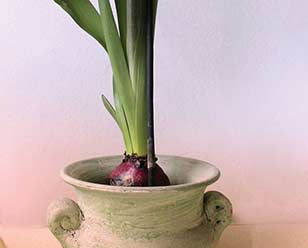
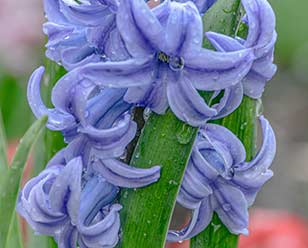
Now is the time to start planting spring bulbs. Daffodils, grape hyacinths and tulips can all be planted between September and December, usually at 2- 3 times the depth of the bulb. I prefer to plant hyacinths in pots and leave outside somewhere cool. This is a lovely occupation for children. Small terracotta pots can be bought cheaply. Plant up the pots with odd number of hyacinths 1, 3 or 5 or more. Do not be tempted to bring the pots indoors too soon or to put them somewhere too warm, they will bolt and wilt.
Summer 2020
How to grow plants from shoots and seeds
Nurturing greenery, whether indoors or out, has become a focus for many of us during these times. With limited stock in some garden centres, there are still ways to make the most of what you have already.
Lift and divide daffodils, snowdrops, and bluebells while the leaves are still showing on the surface. Daffodils have a tendency to become shallow and eventually blind, dig them up, separate the bulbs and replant making sure they are planted about 6 inches deep with a handful of compost, this will help build up the bulbs again and in a year or two they should start to flower again.
Tomato plants seems to be scarce this year, many growers did not plant them in March and April due to the lockdown. To increase your stock of plants, remove side shoots and grow on as cuttings in pots of compost.
Annual poppies, pot marigolds, fox gloves, stocks, evening primrose, and hollyhocks are just a few of the plants that prefer to come from seed when sown directly into the ground. These seeds are often saved by garden enthusiasts so it may be worth asking around to beg a few.
Cranesbill geranium
These hardy and obliging plants come in an ever-increasing range of colours, the most prolific are pink and purple, but the blue, blue and white striped, white and crimson pink are all great additions to any garden. To propagate, divide the whole plant, and replant smaller pieces ensuring they have a good root, some humus and plenty of water to get them started. After flowering is best. When they have finished their first flush of flowers, trim them right down and get a second flush of flowers a few weeks later
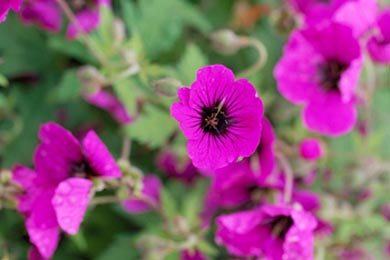
Cranesbill geraniums
Spring 2020
Despite the erratic temperatures that ushered in spring we have enjoyed a flourish of flowering bulbs and blossom from cherry and crab-apple trees, throughout Dulwich.
Dividing snowdrops
On a recent winter walk, I was encouraged by the tiny droplets of white flowers pushing their way up through the ground. Snowdrops are the first bulbs to show their heads in defiance of the cold. If you are fortunate enough to have these in your garden, lift a clump when they have finished flowering, carefully separate the bulbs and replant in bunches of six or more. Snowdrops must be divided up whilst they are still green - don’t be tempted to buy dried bulbs later in the year they have a very poor success rate.
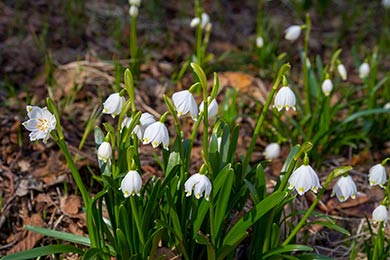
Snowdrops
Planting shrubs and trees
Early spring is also a good time to turn to shrubs and trees while the ground is wet and they are dormant. Small trees can work well in an urban garden. Make the tree work for you. When choosing a fruiting tree, plum, apple, crab apple or pear, semi- dwarfing is the best compromise. Full size fruit trees become enormous whilst the dwarf varieties tend not to crop as well. If you have a larger plot, consider a nut tree. Walnuts do well. They have large lush green leaves that give a slightly tropical feel and produce green fruits that surround the walnut.
Remember our guidelines for residents. If your property is leasehold please ensure you have any relevant permissions for tree planting. Download our guidance.
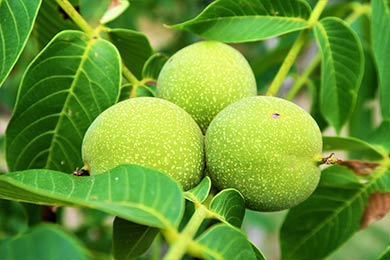
Walnuts
Summer 2019
Box caterpillar
There have been several casualties to our local flora, including a mature flowering Cherry in Dekker Road and many dead or dying box shrubs throughout the area. The box caterpillar is the culprit, fine strands of silk and tiny caterpillars give the game away. The best treatment? Hang pheromone traps (widely available) as near to the shrub as possible and replenish the contents regularly. If the shrub is damaged beyond control, removal and burning of the infected shrub maybe the only solution.
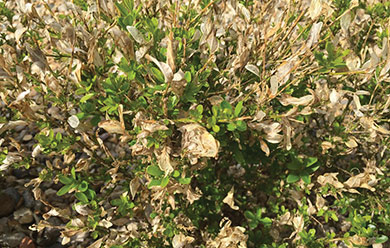
An infected box shrub
Good alternatives to the box hedge should you need to fill a gap are Hebe Rakaiensis, a small
leaved dense evergreen shrub that has the benefit of flowers in June or July. There are larger flower Hebes like the purple flowered Addenda Donna Britta or pink flowered Addenda Donna Nikka. Bear in mind all variegated plants tend to revert to their non-variegated version and this growth will always be stronger, so prompt pruning will be required.
Wasps and bees
Recently I’ve noticed that there is some confusion about wasps and bees. There are a few easy ways to distinguish between them without getting too close. Firstly, a large mass of insects found on a tree, wall or chimney stack are most likely a swarm of bees, and not wasps. This happens in the spring when a spare queen leaves the hive together with a group of followers.
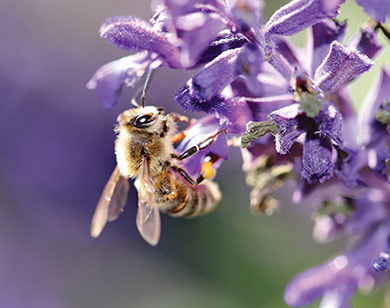
They can be aggressive only if threatened. Keep away from them and you will be fine. Another easy distinction, is the buzz. Wasps make a higher pitched buzz than bees. Bees are endangered and not a pest, absolutely essential to our ecosystem and without them we’d have crop failure.
We are planting to attract pollinators in the Village Orchard. Please help protect them.
Japanese knotweed
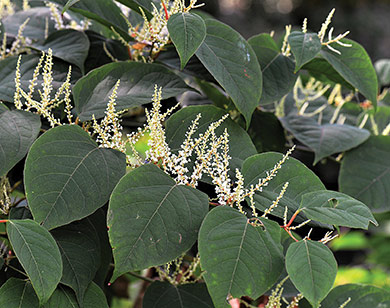
Finally – watch out for Japanese knotweed. This perennial weed is highly invasive and quite prevalent in and around Dulwich. If you identify it, please follow the guidance to prevent it from spreading.
Advice from RHS
Advice from gov.uk


